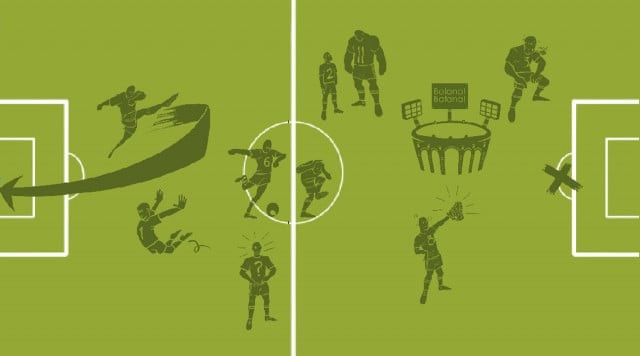Science lifts lid on some of football’s myths

Science lifts lid on some of football’s myths
How can you tell when a player is diving? One telltale is the “archer’s bow,” says British psychologist Paul Morris. This is when a player falls with both arms in the air, with open palms, chest thrust out and legs bent at the knee, like a sprung archery bow.
“This occurs in many dives but biomechanically it does not occur in a natural fall,” said Morris. “Instead, instinctively the arms go down in an attempt to cushion the fall or out to the side for balance.”
HOW IT’S SPUN:
Remember Roberto Carlos scoring “the Impossible Goal,” a swerving spot kick against France in 1997? How did he do it? Some say it’s because Carlos is Brazilian. Physicists, though, point to a combination of the Magnus force and Bernoulli’s principle. Just after a kick, a spinning ball moves forward at relatively high velocity, and the air flows irregularly over it. When the ball slows -- specifically, when it is between 29 to 37 kilometres (18 to 23 miles) per hour -- the airflow becomes smooth, or “laminar,” which instantly boosts the air’s braking effect, sometimes by as much as 150 per cent. This drastically brakes the forward movement of the ball and enhances a curving movement derived from the ball’s spin. So Carlos’ goal initially dipped to the right of the defensive wall and then suddenly swerved into the net, leaving the French dumbfounded.
NO NET GAINS:
Three common beliefs about patterns in goal scoring are false, according to football statisticians gathered at a workshop at Germany’s University of Mannheim in 2006. Firstly, there is no evidence that players who scored in a previous match are any likelier to score in their next game. Secondly, a goal scored just before half time has no greater impact on the outcome of the game than a goal scored earlier in the first half. Finally, teams that have just scored are not especially more vulnerable to conceding a goal than at other times.
SEEING RED:
Football clubs with red team strips are more successful than rivals with other colours, according to a 2008 analysis by the universities of Durham and Plymouth. Red-wearing teams (such as Manchester United, Liverpool and Arsenal) won more often, while teams wearing yellow or orange fared worst. The theory: there’s a psychological boost from wearing red, a colour which is often associated in nature with male aggression and display.
UNPREDICTABILITY:
Those who say football is the world’s most exciting game can take comfort in statistics. Football beat four other major sports (American football, ice hockey, baseball and basketball) for “upset frequency” when the underdog won, according to the Los Alamos National Laboratory. American football was the most predictable. Its “upset frequency” was a whopping 25 per cent less than football.
HOME AND HORMONES:
Could biology explain home advantage? British researchers Sandy Wolfson and Nick Neave took levels of testerone from players before a home game, an away game and at a training session. Levels were much higher before a home game. The male hormone is linked with dominance, confidence and aggression, which implies the lads psyched up to defend their territory.
ALE’S OUT:
Those who contend that drinking beer or other alcoholic beverages helps post-match recovery are addled, say medical researchers. In a New Zealand study published in January in the Journal of Science and Medicine in Sports, volunteers carried out strenuous exercise, which was followed by a meal. Some drank orange juice, while the other drank OJ and vodka, the equivalent to around eight standard alcoholic drinks. The guinea pigs were measured a day and a half, and then two days and a half, after exercise. The alcohol group had 15-20 percent less muscular force than the non-alcohol group, and also reported more soreness. “Even moderate amounts of alcohol” are out.
PENALTIES:
A mathematical study of penalties at Liverpool’s John Moores University puts the death nail into the “blast-it-and-hope” approach.
The perfect penalty, it found, is a ball that is struck high, targeted precisely to the right or left of the goalie, and fast, travelling at 25 to 29 metres per second (90 to 104 kilometres or 56 to 65 miles per hour). Anything faster than this boosts the chance of a miss because of inaccuracy, while anything slower helps the goalie to intercept it.
Seen only through the prism of statistics, the balance in penalties is tilted massively in favour of the taker: between two-thirds and three-quarters of strikes result in a goal, according to various analyses in top-flight European club football.
“The optimum strategy for penalty takers to use is to pick a spot and shoot to it, ignoring the goalkeeper in the process,” said researcher Greg Wood.
HIGHS AND LOWS:
High-altitude countries are known for the advantage they have when playing at home, when low-altitude opponents struggle in the thin air, according to the Britsh Medical Institute. In the case of two teams from the same altitude, the probability of the home side winning was 53 per cent. This rose to 82 per cent for an altitude difference of +3,695 metres, as when high-altitude Bolivia were at home to sea-level Brazil.
Moving swiftly to take the penalty (less than three seconds after the whistle is blown) gives the striker the element of surprise, while delaying the strike by more than 13 seconds makes the keeper unsettled, according to the researchers, who looked at decades of international matches involving England.
Waiting for the goal-keeper to move also boosted chances. However, waiting longer than 0.41 milliseconds caused a scoring chance to be halved. A runup of four to six steps was the most successful approach, while a long runup of 10 metres was the least.
Published in the Express Tribune, June 10th, 2010.



















COMMENTS
Comments are moderated and generally will be posted if they are on-topic and not abusive.
For more information, please see our Comments FAQ